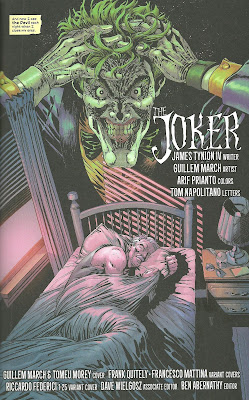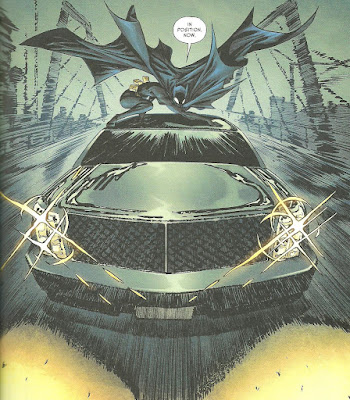1.) Guillem March draws several "cover" images of panels and scenes from The Killing Joke. Because writer James Tynion IV and artist Guillem March's
The Joker is about the title character but uses former commissioner James Gordon as its protagonist, the book revolves quite a bit around the relationship between the two character, particularly the villains many and varied attacks on Gordon and his family over the years.
Naturally, Alan Moore and Brian Bolland's 1988 Batman: The Killing Joke is therefore repeatedly referenced, being not only one of the most widely-read and influential Joker stories, but also because it was specifically about The Joker's attempt to drive Gordon "mad", in part by attacking and torturing his daughter, Barbara Gordon.
The Joker Vol. 1 is very much a comic book in conversation with other comic books, particularly The Killing Joke, but there are other conversations happening as well (like, for example, Tynion seemingly criticizing the climax of Tom King's run on Batman by having The Joker offer his professional criticism on how best to hurt Batman to Bane, as previously mentioned in my review of the book).
Because the events of The Killing Joke are so often referenced, we get the opportunity to see March draw scenes from that storyline in his own style, and, from a certain perspective, it is certainly interesting to see how March does so, having to be clear in what he's referencing while also making the imagery his own.
Above is a scene from the first issue of The Joker, offering a pretty direct "cover" version of a Bolland image of the Joker, right down to mimicking the pose.
 |
| Bolland |
It's fascinating to compare the two images, to see what March considered important to keep and what he felt free to change.
March's Joker looks less...happy, his lips contorted in a smile, but his teeth forming more of a grimace and the rest of his face looking angry. There's also a highly textured cragginess about The Joker's face as March draws it, with seemingly every ince of it spider-webbed with contorting muscles.
In general, I think March's Joker owes more to that of Jim Aparo than to Bolland's.
2.) I think March is the best artist who is currently drawing Batman on a regular basis. Don't get me wrong. I still think Norm Breyfogle drew the ultimate version of the character, and Kelley Jones' version is still my favorite version, and I still think Jones is the greatest living Batman artist (although there's much to be said for Tim Sale, too). But among all the artists who draw the character regularly, or even semi-regularly? March has my vote.
Batman doesn't appear as often as one might expect in The Joker, his appearances in the first collected volume mostly clustered around the beginning as the premise of the series is set up, but here's his first appearance in the book, crouching like a gargoyle on a bit of Gotham architecture, as is his wont.
It's a pretty nice image of Batman doing something extremely Batman-ly, in which he looks quite causal doing it, as if it's just an everyday part of his job, which I suppose it is. March has the ability to find the right balance, I think, between Batman as a real flesh-and-blood human being and a bigger-than-life, almost cartoonish creature of the night. (Note the musculature of his legs and shoulders on the one hand, and the blank eyes, too-big cape and the bleeding-into-shadow on the other hand.) That is, in my mind at least, exactly how Batman should appear.
3.) Look at this scary-ass Joker. Gordon's narration makes much of the fact that he basically sees The Joker every time he closes his eye, and that the character seems to haunt him. The artwork shows several examples of this, but March isn't content just to draw phantom Jokers leering at Gordon through windows or above his bed while he sleeps.
When Gordon visits the grave of his son, we're presented with this nightmare version of The Joker, with multiple limbs, faces and facial features, like the character is boiling.
It certainly drives home the extent to which terrifying imagery has permeated Gordon's life, that such visions of The Joker are basically just background noise for him now.
4.) March draws a good Batgirl, too. So I've repeatedly talked about how I think Breyfogle's Batman was the ultimate version of the character, as he drew Batman as a thoroughly human, athletic figure—in peak physical condition, sure, but still recognizably human—that
wore the Batman persona, as from the neck up his face was constantly transforming into angry white triangle eyes and bared teeth over a field of black, and his billowing cape forming the shape of bat-wings or an angry, jagged cloud, or trailing him like a comet.
I haven't seen much of March's Batgirl, but he does something similar with her here, and I think his depiction of the Cassandra Cain version of the character is exactly right: A female silhouette, a too-big, billowing, expressive cape, a cartoon bat from the neck up. He even has her oversized utility-belt pouches flopping while she's in action, just as her co-creator Damion Scott used to draw her.
5.) Here's another scary-ass Joker. Relatively late in the first volume, Gordon and other characters are caught in a blast of what The Joker calls a nerve gas, which obviously influences the way Gordon sees and experiences The Joker.
Note the multiple visions of him in the same panel, which seems to echo the earlier vision Gordon had of him, and how March is able to exaggerate some of the character's features in the lower panel of the page, despite how exaggerated his design for the character—and, indeed, pretty much everyone's design for the character—already is.
In this story, The Joker's right eye has been replaced with a glass eye, Harley Quinn having shot his eye out at the climax of "The Joker War" story arc, and March makes good use of it throughout as just one more weird and off-putting detail of the character's face. In theat final image, it positively bulges out like it's about to pop.







No comments:
Post a Comment